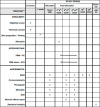Amber photobiomodulation versus tranexamic acid for the treatment of melasma: protocol for a double-blind, randomised controlled trial
- PMID: 37479524
- PMCID: PMC10364183
- DOI: 10.1136/bmjopen-2023-073568
Amber photobiomodulation versus tranexamic acid for the treatment of melasma: protocol for a double-blind, randomised controlled trial
Abstract
Introduction: Photobiomodulation (PBM) has been suggested as an alternative treatment for melasma. In vitro studies have shown PBM with amber light inhibits the tyrosinase enzyme, induces autophagy and reduces the melanin content, but randomised controlled clinical trials are still needed. This study aims to evaluate the efficacy of amber PBM (590 nm) in the treatment of melasma compared with liposomal tranexamic acid.
Methods and analysis: This study is a controlled, randomised, double-blind, non-inferiority trial. This study will be performed in two centres (Universidade Nove de Julho Facility, Campus Vergueiro, and Galache Odontology Clinic, São Caetano do Sul, both in São Paulo State, Brazil). The sample (54 participants) will be divided into two groups in a 1:1 ratio; one group will receive active PBM and a placebo cosmetic and the other will receive sham PBM and liposomal tranexamic acid. Women presenting facial melasma, aged 35-50 years, with skin phototypes II-IV, will be eligible for inclusion. Women who use oral contraceptives, intrauterine devices, hormone replacement or photosensitive drugs, those with autoimmune disease and those who have undergone facial treatments in the last 3 months will be excluded from the study. The participants will receive PBM weekly for 12 weeks and will use the cosmetic two times per day at home during this period. The severity of melasma will be evaluated through the Melasma Area and Severity Index (MASI) as the primary outcome; pigmentation of the epidermis evaluated by corneomelametry, the photographic records, the global diagnosis of the face and the quality-of-life questionnaire (Brazilian Portuguese version of the Melasma Quality of Life Questionnaire) will assessed as secondary outcomes. All assessments will be made before starting the study (week 0), mid-study at 6 weeks and at the completion of treatment (week 12). MASI will also be evaluated during follow-up (weeks 16 and 20). The data will be analysed based on the intention-to-treat analysis using a generalised mixed model, and α <0.05 will be considered statistically significant.
Ethics and dissemination: The protocol was approved by the Research Ethics Committee of Universidade Nove de Julho (5 332 384). All participants will fill out the patient informed consent form. The results obtained in this trial will be presented at conferences and submitted for publication.
Trial registration number: ClinicalTrials.gov Registry (NCT05326997).
Keywords: Adult dermatology; Laser therapy; Photodermatology.
© Author(s) (or their employer(s)) 2023. Re-use permitted under CC BY-NC. No commercial re-use. See rights and permissions. Published by BMJ.
Conflict of interest statement
Competing interests: TRG is speaker for Rennova in Brazil and received the products to be used in the project: Sunscreen SPF 60 Facial Toning Rennova Soleil, Rennova Beauté micellar water, cleansing foam and moisturising mist. None of the other authors have disclosures to declare.
Figures



References
Publication types
MeSH terms
Substances
Associated data
LinkOut - more resources
Full Text Sources
Medical
